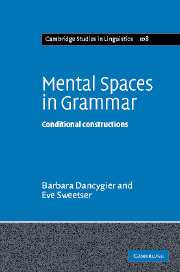Book contents
- Frontmatter
- Contents
- Acknowledgments
- Preface
- Note on abbreviated citations
- The door-scraper in the Wild Wood: an informal lesson in frame metonymy
- 1 Conditional constructions, mental spaces, and semantic compositionality
- 2 Prediction, alternativity, and epistemic stance
- 3 Tense, epistemic distance, and embedded spaces
- 4 Future and present forms in conditional constructions
- 5 Non-alternatives and alternatives: mental spaces in different domains
- 6 Then and even if: mental-space deixis and referential uniqueness
- 7 Clause order and space building: if, because, unless, and except if
- 8 Uniqueness and negative stance: only if and if only
- 9 Coordinate constructions and conditional meaning
- 10 The door-scraper in the Wild Wood: conditional constructions and frame-based space building
- References
- Author index
- Subject index
9 - Coordinate constructions and conditional meaning
Published online by Cambridge University Press: 22 September 2009
- Frontmatter
- Contents
- Acknowledgments
- Preface
- Note on abbreviated citations
- The door-scraper in the Wild Wood: an informal lesson in frame metonymy
- 1 Conditional constructions, mental spaces, and semantic compositionality
- 2 Prediction, alternativity, and epistemic stance
- 3 Tense, epistemic distance, and embedded spaces
- 4 Future and present forms in conditional constructions
- 5 Non-alternatives and alternatives: mental spaces in different domains
- 6 Then and even if: mental-space deixis and referential uniqueness
- 7 Clause order and space building: if, because, unless, and except if
- 8 Uniqueness and negative stance: only if and if only
- 9 Coordinate constructions and conditional meaning
- 10 The door-scraper in the Wild Wood: conditional constructions and frame-based space building
- References
- Author index
- Subject index
Summary
Katy: If a guy does that then they're considered a pimp cause they get all these girls. A girl does that and they're considered a slut.
(http://www.pbs.org/wgbh/pages/frontline/shows/georgia/video/tpimps.html)And-conjuncts as predictive conditionals
The previous chapters have laid out an analysis of the traditionally central class of conditional constructions in English, namely If P, Q conditionals. How much does this help us with the broader range of conditional constructions? Since each construction is motivated by a variety of factors, and in some cases also by other non-conditional constructions, no treatment of If P, Q conditionals is likely to describe enough facts to explain exhaustively how other constructions serve conditional functions in English. However, much of the analysis presented so far does extend readily to the larger family of conditional and non-conditional constructions which can be used to convey conditional meaning. The analysis further provides regular motivation both for the licensing of non-conditional constructions in conditional uses, and for observed constraints on such licensing.
To begin with, a mental-spaces approach gives a relatively straightforward explanation for some of the common conditional uses of non-conditional forms. Our analysis would predict that conditional constructions' functions should overlap with the contextually conveyed meanings of other space-building constructions, when alternative-based prediction or other aspects of conditional meanings are provided by the lexical semantics or the context. Conditional uses of and and or conjunction such as those in (1)–(3) (italics ours) support this hypothesis:
(1) “We get rid of Coyne and we're clear,” said Hayden eagerly.
(WGT. VH.171)[…]- Type
- Chapter
- Information
- Mental Spaces in GrammarConditional Constructions, pp. 237 - 268Publisher: Cambridge University PressPrint publication year: 2005
- 1
- Cited by



